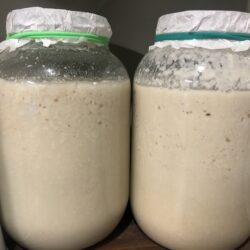Sake log (false start)
Wednesday, January 27th, 2021
Just keeping track of the initial sake experiments. Unfortunalty, this first attempt didn’t make it far. Feel free to learn from my mistakes:
Day 1
9 cups (dry) of sushi rice was prepared. This took 3 batches in my small rice cooker: 3 cups rice + 3.75 cups water for a firmer rice.
Why plain sushi rice? Well this was a bit of an accident. While setting up the cooker for polished rice, my kid spilled the large container of sushi rice. I washed the rice well, but still feel better using it for fermentation rather than sushi. In any case, this is just for the koji – the bulk of the fermentable rice will be polished.
The cook rice was cooled and placed in a large steamer pan. 60g of ‘rice Essence lab’ Koji kin was added. This is probably overkill, but the kin was past the best-by date.
The koji was massaged through the rice around 8pm. A probe was added, the pan was covered with aluminum foil, and places on a heating pad to keep it at 90F.
Day 2
The rice maintained a good temp 88-91F all night.
8am: the rice was gently mixed. It already has a slightly sweet/honey scent. No substantial change in the flavor.
8pm: gently mixed again. The rice has softened considerably. There is also noticeable CO2 buildup due to the foil. The foil was removed and replaced with a permeable towel.
Day 3
8am: gently mixed again. Unfortunalty, the quality of the rice continues to degrade. It still smells/tastes fine – but it has started to turn into mush. This is going to make it quite hard for the koji to propagate in the way we want.
At this point, I think the best call is to start over. It may well be recoverable, but, since this is only the first step in making sake, I want to be sure to get it right.
Lessons?
The overall process and temperatures seemed good. However, I need to work on the texture of the rice and the humidity in the chamber.
Next time:
- Soak and steam the rice. This will give much more control. It will also let me cook much larger batches, which will be important later in the process. After reading this article on koji rice, it becomes apparent the optimal rice is just cooked, with a firm texture.
- Other sources have mentioned coating the cooked and cooled rice with rice flour. This will help keep the grains dry and separated. It should also give the koji an immediate food source.
- Don’t seal the container! I was trapping way too much moisture and CO2. A towel on top should keep out dust, but let the koji breathe. If there are still issues, I could consider raising the rice off the bottom of the pan with a rack for better air flow.
That said…

The koji rice was a mush, but still smelled good – and I have a hard time dumping experiments.
- 2 x 1/2gallon jars were filled
- + water
- + a pinch of yeast nutrient
- + yeast (DADY)
A few days later and the fermentation is going strong. Releasing a good amount of CO2 and smells good. We will wait and see…
02-17 the mixture was strained. Unlike the next batch using steamed rice, this did not go well. The mushy rice clogged the sieves and took quite a while to get into clean jars.

gabriel nagmay (dot com) | Archive » Sake log (take 2) Says:
[…] the rice. After a false start, I am planning to do things right. This time the rice will be soaked and steamed in preparation of […]